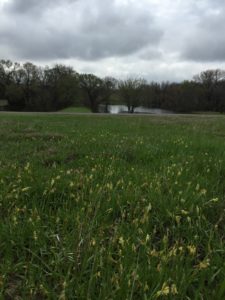by Gwen A. Baumann
 High in a blackland prairie that twists like a tornado from the Red River to the Hill Country sits a little anomaly. It’s the soil found at Erwin Park in north Collin County: Austin silty clay, according to Dave Powell, and that’s a bit of a mystery.
High in a blackland prairie that twists like a tornado from the Red River to the Hill Country sits a little anomaly. It’s the soil found at Erwin Park in north Collin County: Austin silty clay, according to Dave Powell, and that’s a bit of a mystery.
Powell, state program representative for the BPTMN chapter, is also ramrod of the fledgling prairie restoration project at the county park that lies about four miles west of US 75 and equidistance north of US 380.
“This is an interesting area,” Powell said as he walked the property one Saturday morning in March. “Since this isn’t black clay, the soil should have an effect on the plants growing, but I haven’t figured that out yet,” he said. “We’ve got more trees here than I’d like in the prairie,” Powell added, surveying a mott of cedar, smilax, and soapberry, “but the park service wants them, so I say as long as you let me grow the native grasses, I’m happy.”
BPTMN has gotten permission to work on restoring the native prairie to 50 of the park’s 212 acres. The rest of the park hosts miles of mountain bike trails with bike repair stations, playgrounds and picnic spots, campgrounds and ponds for fishing and exploring. “There are a lot of people using these trails,” Powell said. “We want to introduce them to native plants and show them what it looks like.”
To start with, chapter volunteers are “lollipopping” the cedars, cutting them up so that the lowest branches are about six feet off the ground, digging up scabiosa, and picking up trash. The Austin silty clay is one reason Powell is taking it slow. Since he’s not sure of the effect of the silty clay on the grasses and forbs, “we’re leaving it to see what grows here,” he said. “We want to see what prairie grasses and forbs exist before we start trying to worry about putting other things out here.” Milkweed pods have been spotted, though, so he is hopeful.
In the meantime, Powell and other volunteers have been working on the cedars, have seeded for a butterfly way station west of the dam, and have seeded five 10′ x 20′ quadrants with different mixes: pollination, bee, butterfly, hummingbird, and a prairie mix that comes with a full range of forbs.
Volunteers interested in helping first meet with Powell to walk the area and see what’s is needed. “Every little piece of stuff we find that’s not natural we pick up and get rid of. It’s better for nature and for the critters,” Powell said, before issuing a warning. In the summer, volunteers should remember their insect repellent with DEET because the chiggers may be plentiful.
Discover more from Blackland Prairie Chapter
Subscribe to get the latest posts sent to your email.


